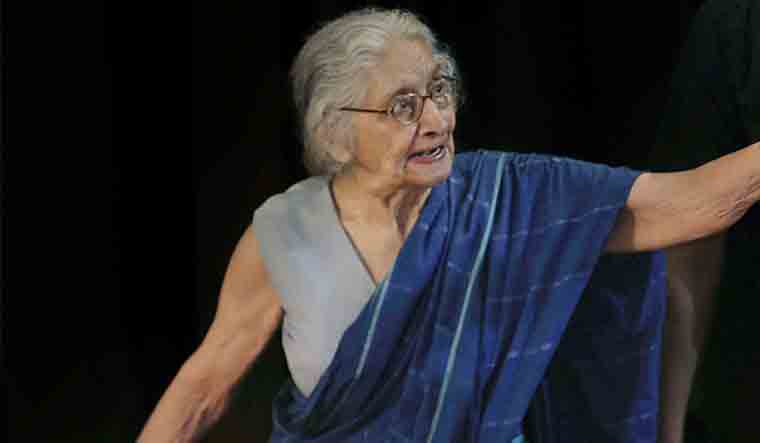Legendary scholar Kapila Vatsyayan passes away at 92
 NEW DELHI : Kapila Vatsyayan, Member of Parliament, a major scholar of art, architecture, Indian classical dance and Founding Director of the Indira Gandhi National Centre for the Arts, passed away at the age of 92 at her home in New Delhi on Wednesday.
NEW DELHI : Kapila Vatsyayan, Member of Parliament, a major scholar of art, architecture, Indian classical dance and Founding Director of the Indira Gandhi National Centre for the Arts, passed away at the age of 92 at her home in New Delhi on Wednesday.
Kapila Vatsyayan, who was awarded the Padma Vibhushan in 2011, was the founding director of the Indira Gandhi National Centre for the Arts. A former nominated member of the Rajya Sabha, she was also chairperson of the Asia Project at the India International Centre (IIC).
The renowned scholar of art history, architecture and Indian classical dance was born in New Delhi in 1928 and did her masters in English Literature from Delhi University and in Education from the University of Michigan in the US. She was the younger sister of poet and critic Keshav Malik.
Kapila Vatsyayan had authored nearly 20 books on different forms of art and their histories in her long career. Some of her notable works include “The Square and the Circle of Indian Arts” (1997), “Bharata: The Natya Sastra” (2006), “Dance in Indian Painting” (2004), “Classical Indian Dance in Literature and the Arts” (2007), and “Transmissions and Transformations: Learning Through the Arts in Asia” (2011).
Recipient of the Padma Vibhushan honour (2011), the scholar, who authored around 20 books on various art forms and their histories including ‘The Square and the Circle of Indian Arts’ (1997), ‘Bharata: The Natya Sastra’ (1996) and ‘Traditions in India Folk Dance’ (1987)was also the Chairperson of the Asian Arts Project at the India International Centre.
Trained in Kathak and Manipuri, she earned her PhD from the Banaras Hindu University after completing her MA English from Delhi University and MA in Education from the University of Michigan in the US.
The younger sister of poet and art critic Keshav Malik, Vatsyayan, being one of the country’s earliest arts administrators, was instrumental in taking the best of Indian artists across the world under the aegis of Indian Council For Cultural relations. She was also awarded the Sangeet Natak Akademi Fellowship in 1970.
The younger sister of poet and art critic Keshav Malik, Vatsyayan, being one of the country’s earliest arts administrators, was instrumental in taking the best of Indian artists across the world under the aegis of Indian Council For Cultural relations. She was also awarded the Sangeet Natak Akademi Fellowship in 1970.
Vatsyayan, who was awarded the Padma Vibhushan in 2011, was the founding director of the Indira Gandhi National Centre for the Arts. A former nominated member of the Rajya Sabha, she was also chairperson of the Asia Project at the IIC.
Vatsyayan was also the chairperson of the Asia Project at the IIC. She was the founding director of the Indira Gandhi National Centre for the Arts. The renowned scholar of art history, architecture and Indian classical dance was born in New Delhi in 1928 and did her masters in English Literature from Delhi University and in Education from the University of Michigan in the US. She was the younger sister of poet and critic Keshav Malik.
Vatsyayan, a former member of parliament and lifetime trustee of the Indian International Centre (IIC), has been described as the ‘grand matriarch’ of cultural research.
Apart from being a dancer – trained in Kathak and Manipuri – and scholar, she also advised several governments on education and culture. She held several posts in the Government of India and in institutions such as the Sangeet Natak Akademi and the Indira Gandhi National Centre for the Arts, which she helped establish.
Jyoti Sabharwal, who wrote the biography Afloat a Lotus Leaf: Kapila Vatsyayan, told that Vatsyayan was born in a Punjabi family of “fierce integrity and courage”. She was born on December 25, 1928, in India. The poet and art critic Keshav Malik was her older brother.
She was married to the noted Hindi Writer S.H. Vatsyayan (1911–1987), who used the nom de plume, Agyeya. Their marriage ended in divorce.
Kaveree Bamzai, writing for India Today, notes that Vatsyayan was mentored by stalwarts such as Kamaladevi Chattopadhyay and Rukmini Devi Arundale, adding that she was “entrusted by generations of Nehru-Gandhis with their showpieces”.
She adds:awaharlal Nehru asked her to take troupes of artists to all parts of the world, in what he called ‘splash diplomacy’ under the aegis of the Indian Council of Cultural Relations. Sarvepalli Radhakrishnan gave her three weeks to turn Teen Murti House into the Nehru Memorial Museum. The always correct Maulana Abul Kalam Azad asked her to write ‘akademi’ 100 times to get the spelling right. Indira Gandhi asked her to prepare an exhibition of Chola bronzes at the National Museum to coincide with the Non-Aligned Movement Conference in Delhi in 1983…”
Vatsyayan was nominated to the Rajya Sabha in 2006, though she resigned in March 2006 after a controversy over her holding an office of profit. She was renominated in 2007, with her term expiring in February 2012.
(With Agency inputs).

